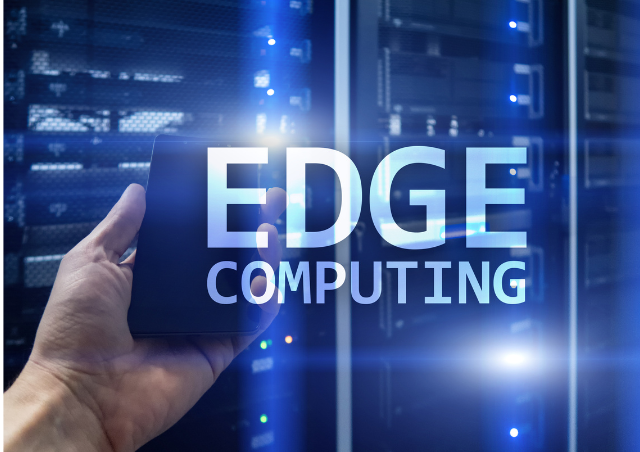Edge computing is rapidly changing how we process data, offering a powerful solution alongside cloud computing and the ever-expanding Internet of Things (IoT).
In a previous article, I explored the capabilities of cloud computing, highlighting the challenges faced by organisations transitioning to this model. Here, I’ll delve into edge computing and how it complements cloud solutions, driving real-time decision-making and streamlining transformations.
What is Edge Computing?
Unlike traditional cloud computing, which centralises data collection and processing in distant data centres, edge computing places that processing as close as possible to the data source, i.e. where data is generated. This reconfiguration of computing resources allows data to be processed either on the device itself, or on intermediary edge servers.
This concept of data proximity to the source is the origin of the term “edge”.
Why Choose Edge Computing?
While it may appear, at first glance, that technology has regressed with Edge Computing due to the decentralisation of data collection and processing, this technology has, in fact, brought significant benefits to the technological landscape, addressing some of the challenges I previously outlined in my article on cloud computing.
The most apparent advantage of edge computing is the reduction in the latency issues experienced in cloud computing. By processing data locally or on nearby intermediary edge serves, real-time computations happen instantly, eliminating the need to wait for data to be sent to the cloud server, processed, and then receive a decision back to the device. For example, in robotic surgeries where split-second decisions can be life-saving, waiting for a decision to arrive from the cloud isn’t an option.
This decentralisation aspect holds particular significance in the context of IoT, where a vast array of connected devices generates a huge amount of data that demands rapid analysis and response. Therefore, this utilisation of decentralized data processing enhances the overall efficiency of the entire network, optimising available bandwidth.
Another noteworthy advantage of edge computing lies in its enhancement of privacy and security. The element of privacy and security concerns was discussed at length in my previous article about cloud computing, where I highlighted that organisations must ensure that their cloud provider offers the right level of security measures. Adding complexity to the mix, different countries may have varying legislations compared to those imposed on the cloud provider, posing challenges for both to sync. With edge computing, sensitive data can be retained and processed on the device itself, mitigating both risks. Furthermore, it reduces the risk of data breach since data is not transferred over a network.
Another advantage of edge computing stems from its approach to data storage and processing. Instead of transmitting data to the cloud server, this technology stores and processes data within the devices themselves, resulting in significant cost savings. This is due to the reduced need for extensive storage space, power, and other cloud computing resources on the central server.
Finally, in situations where internet connectivity is limited or unstable, maintaining constant communication with the cloud will not be possible, potentially bringing down certain key services. Contrastingly, edge devices provide enhanced reliability as they can continue processing data autonomously, ensuring critical operations remain functional.
How Does Edge Computing Support Organisations in Their Transformations?
Agile Transformations
With its quick, decentralised decision-making capabilities, organisations can respond rapidly to the environment, fostering a more agile and adaptive culture.
Digital Transformations
Edge Computing offers organisations the ability to create intelligent, connected ecosystems, leading to a more digitalised operating model and a more digitally mature organisation.
Data Transformation
By avoiding the transfer of all data in its raw format to a centralised server, Edge Computing supports organisations in optimising their data handling, promoting more efficient data flows.
Operational Transformation
With data processing happening locally on the devices themselves, operations may no longer remain heavily dependent on the internet, reducing overall downtime.
Security Transformation
As discussed earlier, the local processing of data by Edge Computing contributes to achieving security transformation goals by minimising risks associated with the transmission of sensitive information.
Customer Centricity Transformation
With decisions happening instantly, Edge Computing equips organisations with the ability to deliver real-time and personalised services to their customers.
Sustainability Transformation
By optimising resource usage and reducing the need for constant data transmission, Edge Computing aligns seamlessly with sustainability goals, supporting the organisation’s commitment to environmental responsibility.
It’s important to note that despite these benefits, edge computing is not positioned to replace cloud computing. One of the key reasons lies in the strain edge computing places on the device batteries and storage. Furthermore, in scenarios involving the need for diverse data from different devices for complex decision-making, this may necessitate bringing data together to a central place. Beyond data accessibility, processing all this data will require a substantial amount of power, something which edge devices may not be able to provide. Additionally, this data can be fed to AI models for training purposes, escalating the demand for more power.
With all these available technologies, leaders need to monitor how to leverage them in their transformative journey, balancing innovation with security, efficiency, and strategic alignment.
By doing so, they lay the groundwork of an adaptable and forward-thinking organisation – one that copes with the present challenges while embracing the opportunities of the future.
I’m Jonathan Spiteri, and I bring a wealth of experience in innovation, strategy, agile methodologies, and project portfolio management. Throughout my career, I’ve had the privilege of working with diverse teams and organisations, helping them navigate the ever-evolving landscape of business and technology. I’ve also earned multiple prestigious certifications, such as Axelos Portfolio Director, SAFe® 6 Practice Consultant, Organisation Transformation, Project Management Professional (PMP), TOGAF 9.2, and Six Sigma Black Belt. These qualifications reflect my dedication to achieving excellence and my proficiency across various domains.


